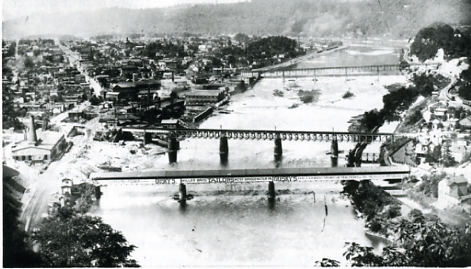
Beaver Falls in the 1890s. Note the covered bridge in the foreground.

Even before a road was opened under a decree of Court from what is now Rochester to the ford of the Big Beaver at Old Brighton, the necessity of a bridge at the letter point was apparent. No settlement as yet existed east of the crook, but the embryo town of Brighton,, west of the stream already contained a couple of factories and severtal log dwellings, so the necesaary steps were taken for that purpose.
On March 20, 1810, the 'Legislature deeded a charter under the ponderaus title "The President., Managers and Company for erecting, a bridge over the Big, Beaver Creek opposite the town of Brighton and named Abraham Wellington, Jonathan A. Mendenhall, Benjamin Townsend, Isaac Wilson and Jacob Yoho commissioners to receive stock subscriptions.
By September 14 1814, 238 shares had been sold at $25.00 per share, and on the same day at a meeting in the (inn) of Thomas Ross; at Old Brighton the following officers were elected: President Samuel Adams: Treasurer Samuel Jackson; Managers Jeremiah Barker,Jeremiah Britton, John Armstrong,John Pugh, James Taylor and Isaac Wilson. The contract for erect ion was given to Persifor Taylor and Joseph Hoopes.
It was to be a frame truss wooden bridge, 20 ft wide, to stand on framed piers and abutments and flanked on the outside, evidently to to filled in with rock later. It was to be built as a continuation of Third Avenue in a direct line northward, the western end to rest about where the Beaver Falls ramp, of the county bridge now stands.
The new bridge was built and opened for traffic on November 11, 1815 with Joseph Townsend as toll-collector at a salary of $130.00 per year.
After the bridge had been in operation about
two years an evil day came upon it. On March 3. 1818, due to high
water and a heavy drift of ice as it went out in the spring.,
one pier and two spans were carried away. Dams which shattered
the ice as it went out in the springs had not yet
been built, and it come down as large fields. No attempt at rebuilding
was made and again the fords or the ferry at Sharon were used.
Since no officers were elected for 15 years the charter was forfeited.
In 1832-33 Old Brighton was enjoying its first real prosperity and gaining in population. The Canal was starting operations and New Brighton was beginning its career, so the need for a bridge between the two villages was increasing daily. Again the progressive residents got busy. On April 8,, 1833 the legislature approved a new charter for another bridge with substantially the same name and in the language of the first bridge; and appointed James Patterson, David Hoopes, David Townsend, John C. Hunter and John Boles to receive stock subscriptions. Sufficient stock having been subscribed, a contract was given to Farrow & Martin, for a covered bridge modeled on the lines of the one previously erected at Rocheste.r It was to be considerably shorter than the wrecked structure-500-feet, and to be thrown more directly across the stream, thus requiring a short roadway to it from Third Avenue. Joseph Hoopes was made superintendent of construotion, but on July 19, 1834 Farrow and Martin abandoned their contract and Wm. Le Baron,, who had built the Rochester Bridge, was given the task of completing the bridge. In the spring of 1835 he turned over to his employers a finished structure that was a monument to the Le Baron name for over 64 years. It was at once opened for traffic with Nathaniel Coburn (Rev. War Veteran-Buried in Grove Cemetary) as its first toll-taker, at $100.00 annual salary. The bridge cost about $15,000, and was a profitable investment for its stockholders. When it was torn down in 1900, it was said by competent engineers to be stronger than the flimsy steel over-grade bridge which replaced it in 1901. However, irrespective of its strength, every boy in the two towns knew the elephants in circus processions always waded the stream, refusing to set foot on the structure. The Brighton Bridge was without a foot walk until 1870, when one was constructed upon the northern side. Pedestrians were perforce obliged to make their way through the filth of the roadways, where cows, which ran at large, were in the habit of gathering after nightfall, much to the disgust of the people.